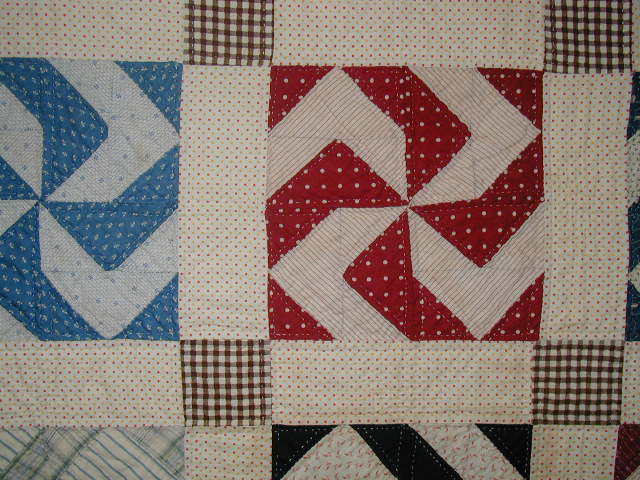 |
| 69" x 81" |
The ancient symbol depicted in this pieced block has had various positive meanings in many cultures and religions over thousands of years; good luck, well-being and fertility to name a few.
The design enjoyed a brief surge of popularity early 1900's to about the 30's. This seems to be the time period of most of the quilts using the design that I've come across.
Once the design became the symbol of the Nazi party it was naturally associated with the ideologies of that party and is now largely stigmatized in the western world. In fact, it is currently out-lawed in Germany. (See wikipedia for more information.)
I purchased this top together with the Jacob's Ladder in my last post. Dealer Bill Wivell admitted he wanted to 'get rid of it'! Clever Bill tried to improve his odds calling the quilt "Tumbling Logs" on his price tag. I smiled at him. No one was fooled but...nice try.
It is backed with a plain white cotton sheet. The blocks are set in a zig-zag setting.
It's another example from one of my favorite time periods. I love the fabrics - especially the pink plaid used for the generous separating strips and borders.
It is a good addition to my collection to be used in lectures. It definitely gets attention and provides a chance to educate the audience about this symbol as used in early quilts.
Now here's an interesting/curious quilt I saw at an exhibit in the historical society of Sanibel Island, FL, in 2007. It was shown folded so this is the best photo I cuold get. I hadn't seen this block before - I had to get a closer look..........
...........and then I realized what I was seeing.......
It was a Swastika quilt. Someone had appliqued squares - almost (but not quite) a match of the original blue - turning the swastika into a closed square or window pane. She did a great job; even matching hand quilting to the rest of the quilt.
The innocent maker, pre-WW II, would have had no idea her quilt would someday cause such discomfort and offense. Someone had an idea of how to make the changes that would allow it to still be seen and used.
 |
| c. 1900 |
I've always called it 'Fly Foot'. In fact, a bit of research indicates that the name is probably derived from Fylfot - (yes, that's the spelling) meaning four footed.....again click here for more about that.
The symbol is not exactly like the swastika shown in the first two examples but you will find many examples of this variation when you search the Quilt Index using the word Swastika. Alternate names include Whirlygig and Devil's Puzzle.
 |
| Did you notice the polka dot sashing?! |
Next: Summer Break: 'Up North'




Wow, what a fantastic post. I'm most taken with the quilt that has the appliqued blue. You can imagine the feelings that were going on then. Again, great post. Thanks. *karendianne.
ReplyDeleteFascinating post. Love the old quilts. Thanks for sharing this with us.
ReplyDeleteVery interesting Jean. I love the detail in your posts and the photos to support the information.
ReplyDeleteThank you for sharing.
How funny is the one from Sanibel?! The on-point, framed block top is cool; great blues! The scrappy one is eye-catching, too!
ReplyDeleteLove the old blues.........
ReplyDeleteWhat a great story about the old blue and white Swastika quilt being changed to hide what it had originally been!
ReplyDeleteI have an old thin swastika block design quilt. It isn't in very good condition but it is interesting. I got it in a lot of textiles at an auction a few months ago...entire lot for $10 & I have sold all the other pieces. Just decided now to actually do some research on the design & came across your Blog.
ReplyDeleteI recently inherited a swastica quilt in red/white/blue made in Minnesota, dated 1933, by my gr-grandmother who was of German descent. I have since learned that there was a resurgence of pride in the German immigrant community, not unlike the Mexican-Americans flying the Mexican flag.
ReplyDelete